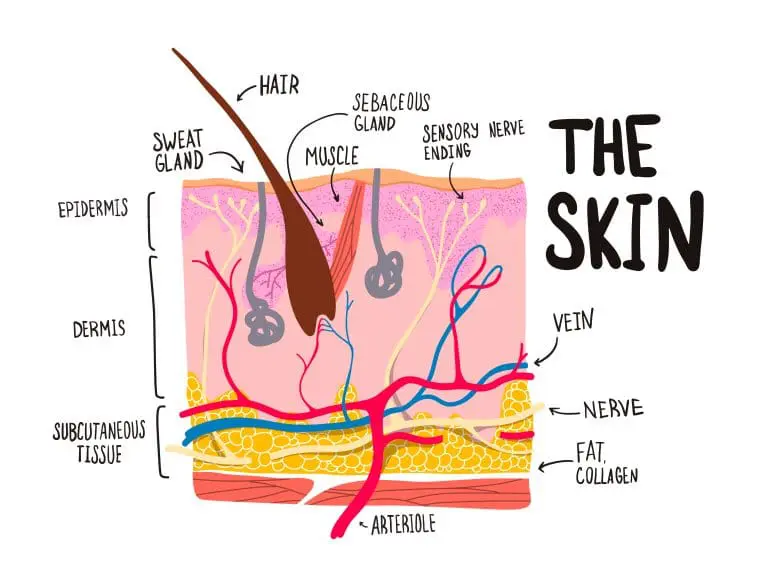What are the main functions of the skin?
The surface of the skin is between 1.5 and 2 square meters for an adult with a body weight of about 70 kg. The skin has the following main functions:
- protective function – the stratum corneum protects our body from damaging agents and water loss. If this layer is removed, water loss can increase 10-20 times. The acidic reaction (pH 5-6.5) characteristic of the stratum corneum is an obstacle to the penetration and development of microorganisms in the skin and the body in general. Through the formation of the melanin pigment in it, the body protects itself to a certain extent from the deeper penetration of ultraviolet rays.
- excretory function – using sweat and other glands in the skin, several end products of metabolism are released from the body, and some components of body fluids are regulated. With sweat, in addition to water and sodium chloride, urea, phosphates, and sulfates, acetone bodies are released. For 24 hours, in some cases, up to 20 years can be allocated. sodium and 10 g of nitrogen. In this way, the skin complements the functions of the kidneys and liver.
- exchange function – the skin has an important role in the exchange of substances. Significant amounts of water, salts, fats, proteins, and vitamins accumulate in it. Under the action of ultraviolet rays, the provitamin D found in the skin is converted into vitamin D3, which is essential for calcium-phosphorus metabolism.
- respiratory function – under normal conditions, the skin is not particularly important for giving off CO2 and taking in O2. During physical work or high temperatures, the intake of O2 through the skin increases and can reach up to 730 ml. per hour.
- thermoregulatory function – the skin participates in the process of thermoregulation in several ways – by evaporation of moisture and sweat from its surface, by heat radiation, and by heat conduction. Subcutaneous adipose tissue is a poor conductor of heat and protects the body from heat loss.
- reservoir function – skin blood vessels have a significant capacity. At maximum expansion of these vessels, they can hold up to 1 liter of blood.
How is the nail constructed?
Nails are horny plates lying in the nail bed.
The nail grows from a plate in the area of the nail root – a nail matrix, the cells of which quickly antagonize and are included in the horn plates of the nail.
How is hair structured?
Hair has two parts:
- root – located in the dermis
- trunk – protrudes above the surface of the skin
It lies in the formation of the epidermis – a hair follicle. Attached to the hair follicles are bundles of smooth muscle fibers that are responsible for the movement of the hairs. When they are shortened, the hairs stand up and the skin shrinks to a certain extent – “goosebumps”, thus reducing the release of heat through the skin. In this way, the skin participates in the regulation of heat exchange in the body.
How is human skin structured?
The skin is one of the largest organs of the human body – it represents 5% of the total body weight. It has a diverse function – it protects the body from the harmful factors of the external environment, participates in the release of waste products, participates in heat exchange, and the regulation of water balance in the body. A large number of tactile, temperature, and other nerve endings are located in it – it represents a huge receptor field.
The skin consists of two main layers – the epidermis and the dermis. Under the dermis is the subcutaneous tissue, which is mainly made up of fatty tissue with different expressions in different parts of the body. The cells of the epidermis form the protein substance keratin, which is important for its protective function, and also melanin – a pigment that protects the body from the harmful effects of ultraviolet rays.
The surface of the skin is not completely smooth but is striated with fine lines that have a different course in different parts of the body. These lines are formations of the dermis and are most pronounced on the palms and soles, where they form a pattern with strictly individual characteristics. Because of this, fingerprints and palm prints, called dermatoglyphics, serve to identify people in forensics and forensics.
Hair and nails are formed from the epidermis. They are called skin appendages.
